The wind sweeps over the weathered stones of Cape Coast Castle, carrying the echoes of forgotten souls. Here, the past never sleeps. It clings to the walls, to the rusted chains, to the silent screams that history has never truly erased.
But Cape Coast Castle is not the only witness to this painful memory. A few kilometers away, Elmina Castle stands, imposing and silent, another relic of the transatlantic slave trade.
Two fortresses, two scars on Ghana’s coastline, two places where history was carved in chains and tears.
Elmina and Cape Coast: two fortresses, one tragic legacy
It’s impossible to talk about Cape Coast Castle without mentioning Elmina Castle. While Cape Coast is often the most visited, Elmina is the oldest and largest of West Africa’s slave forts.
Built in 1482 by the Portuguese, Elmina was the first European settlement in sub-Saharan Africa. Before becoming a hub for human trafficking, it was a center for gold and ivory trade. But soon, what passed through its doors were not riches, but lives.
Cape Coast Castle, built later by the British, was smaller but just as significant. It served as a key point in the transatlantic slave trade, where thousands of men, women, and children were forced onto ships bound for the Americas.
The difference between the two? Elmina Castle is massive, an architectural beast towering over the coast, while Cape Coast is smaller, tighter, more claustrophobic.
One was controlled by the Portuguese and later the Dutch. The other by the British. But inside their dungeons, the languages spoken by the captors didn’t matter—pain and captivity were the same.
Between two walls, between two worlds
I remember the day in 2016 when I visited both castles. Elmina first, then Cape Coast.
Elmina is vast, overwhelming. The thick white walls, the high ceilings in the governor’s quarters, the stark contrast between the luxury of the colonizers and the suffocating darkness of the slave dungeons. The air feels heavy, thick with unspoken history.
Cape Coast, on the other hand, is smaller but more haunting. Its corridors are narrower, its dungeons more compact, making it even harder to fathom how so many people were crammed inside. Where Elmina crushes you with its size, Cape Coast suffocates you with its intimacy.
In both places, history grips you and forces you to look.
The door of no return: the last step into oblivion
At Elmina, the guide led us to the Door of No Return—the narrow passage through which captives were forced onto waiting ships. Beyond it, only the ocean.
I had seen photos before, I had read about it. But standing in front of it, I felt what words could never fully capture.
At Cape Coast, the door is even more striking.
It is small, unassuming. And yet, it holds everything.
Through it, thousands walked their final steps on African soil, never to return.
I stood there, unable to move.
I thought about my own journey.
Me, a Togolese, born on the land of my ancestors. Free to live here, free to leave and return at will.
And yet, in Europe, where I studied, in Bordeaux, a city that grew rich from the transatlantic trade, I often felt the weight of history in a different way.
The silent judgments. The lingering echoes of colonial arrogance. The subtle questions: “Where exactly are you from?” “So, when do you plan to go back?”
Cape Coast made me realize something.
This feeling of displacement, of being both at home and a stranger, was an echo of those who had been taken.
A duty of remembrance: visit, understand, never forget
I walked out of those castles with a heavy heart.
But also with a certainty: these places must be visited.
They are not just historical ruins. They are living memories, stories etched in stone.
If you are African, if you are of African descent, if you are simply a human being seeking to understand where we come from, what we have endured, and why the world is the way it is today, then you must visit Elmina and Cape Coast.
You must step into those dungeons, feel their weight, touch the walls that have heard everything.
You must stand before the Door of No Return, and grasp what it means.
And when you leave, you must carry that memory with you.
Not as a burden, but as a responsibility.
Because forgetting is a privilege we cannot afford.
Elmina and Cape Coast remind us that history does not disappear. It lingers in the stones, in the waves, in the wind.
And it is up to us to listen, to remember, and to carry it forward.
Make the journey. Enter these silent fortresses. Listen. Feel. And never forget.
Edem Cédric FIADJOE


